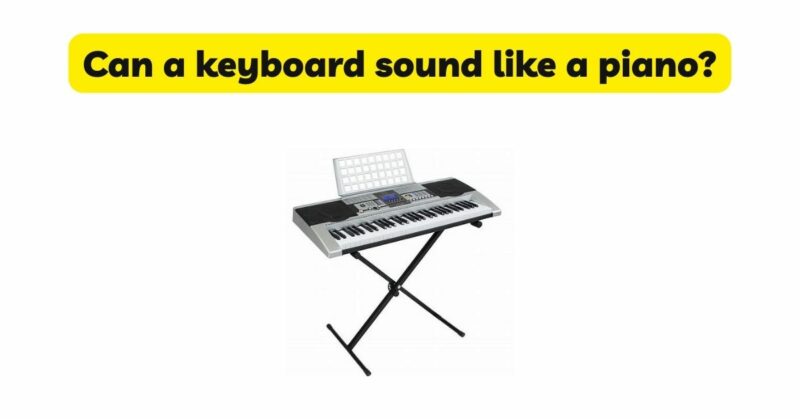The pursuit of a keyboard that can replicate the iconic sound of a piano has been a long-standing goal for musicians. While acoustic pianos possess a unique and distinctive sonic quality, advancements in technology and sound engineering have brought keyboards remarkably close to emulating the sound of their acoustic counterparts. In this article, we delve into the factors that contribute to a keyboard sounding like a piano, including sound sampling, sound modeling, sound processing, and speaker systems. By examining these elements, we aim to provide insights into the capabilities of keyboards in recreating the authentic and resonant tones of pianos, helping musicians make informed decisions based on their musical preferences and needs.
- Sound Sampling: One of the primary methods used by keyboards to replicate the sound of a piano is through sound sampling. High-quality keyboards incorporate extensive sample libraries recorded from real acoustic pianos. These samples capture the nuances and tonal characteristics of each individual key, including the attack, sustain, and decay of the piano sound. By mapping these samples to the corresponding keys on the keyboard, keyboards can recreate the timbre, dynamics, and resonance of an acoustic piano, bringing musicians closer to the rich tonal qualities of the original instrument.
- Sound Modeling: Sound modeling is another approach employed by keyboards to replicate the sound of a piano. This technique involves creating algorithms that mimic the behavior and characteristics of acoustic pianos. Modeling technology takes into account the physics of piano sound production, including the interaction between strings, hammers, and resonant bodies. By accurately simulating these interactions, keyboards can reproduce the tonal nuances and subtleties that are unique to pianos. Modeling technology offers musicians the opportunity to customize and shape the piano sound to their liking, further enhancing the realism and versatility of the instrument.
- Sound Processing: Keyboards utilize sound processing techniques to refine and enhance the piano sound, aiming to create an authentic and realistic playing experience. Digital signal processing algorithms are employed to simulate the resonance, harmonics, and decay of piano tones. Techniques such as sympathetic string resonance, key-off samples, and damper pedal emulation contribute to the realism and depth of the piano sound. Through sophisticated sound processing, keyboards can recreate the subtle nuances and characteristics that define the sonic identity of a piano.
- Speaker Systems: The quality and design of the speaker system in a keyboard play a significant role in reproducing the rich and complex sound of a piano. High-quality keyboards incorporate dedicated speaker systems that are designed to accurately project the nuances and dynamics of the piano sound. The positioning, configuration, and quality of the speakers contribute to the spatial representation and clarity of the sound. Additionally, some keyboards offer the option to connect to external amplification systems or studio monitors, further enhancing the sound reproduction capabilities.
- Multi-Sampled and Velocity-Sensitive Keys: To enhance the realism of the piano sound, keyboards often utilize multi-sampled keys and velocity sensitivity. Multi-sampling involves capturing multiple samples of each key at different velocity levels, ensuring a smooth transition and accurate representation of the sound as the player varies their playing intensity. Velocity sensitivity allows the keyboard to detect and respond to the force or speed at which each key is pressed, resulting in variations in volume and tone, just like an acoustic piano. These features contribute to a more expressive and nuanced piano sound.
- Hybrid Pianos: Hybrid pianos offer a unique blend of acoustic and digital elements, providing a sound that is close to an acoustic piano while incorporating the benefits of digital technology. These instruments combine a real acoustic piano action with digital sound generation and customization options. The acoustic components, such as strings and hammers, contribute to the authentic touch and response of a piano, while the digital elements allow for versatility in sound selection and customization. Hybrid pianos strive to deliver a piano sound that closely emulates the rich tonal qualities of their acoustic counterparts.
Conclusion: While keyboards cannot fully replicate the intricate nuances and complexities of an acoustic piano, significant advancements in technology have allowed them to come remarkably close in emulating the sound of pianos. Through sound sampling, sound modeling, sound processing, speaker systems, and features like multi-sampled keys and velocity sensitivity, keyboards can reproduce the rich tonal qualities, dynamics, and nuances associated with pianos. Additionally, hybrid pianos provide a compelling combination of acoustic and digital elements, offering a sound that is close to an acoustic piano while incorporating digital capabilities. While each keyboard may have its unique characteristics and limitations, finding a keyboard that comes close to replicating the sound of a piano can offer musicians a satisfying and immersive playing experience. By selecting a keyboard that provides a piano-like sound, musicians can unlock their creativity, explore various musical styles, and enjoy the pleasure of playing a versatile and expressive instrument.


